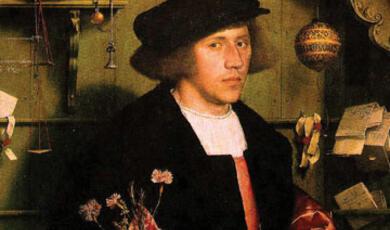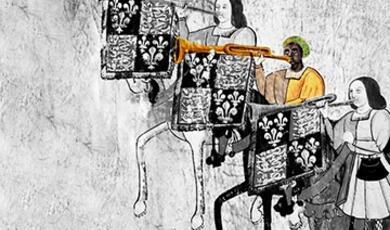Sir Christopher Wren and the Rebuilding of the City Churches after the Great Fire of London
Share
- Details
- Text
- Audio
- Downloads
- Extra Reading
In this lecture, Anthony Geraghty will reveal how Sir Christopher Wren went about rebuilding over fifty churches in the decades after the Great Fire. He will describe the several factors - economic, political, religious, aesthetic - that shaped the appearance of these much-loved buildings.
Download Text
30 June 2015
From Astronomy to Architecture:
Sir Christopher Wren, Gresham College, And the Rebuilding of the City Churches After the Great Fire of London
Anthony Geraghty
I would like to begin my lecture with another lecture delivered in Gresham College. This other lecture was delivered in 1657, obviously not in this room, but within the very institution that was kind enough to invite me to speak to you this evening. That other occasion was the inaugural lecture of the ninth Gresham Professor of Astronomy. His name was Christopher Wren and he was 25 years old. This was his first academic position and great things were expected of him; he was, as John Evelyn put it, a ‘miracle of a youth’.
Wren, who was to live for another 66 years, is best known as the architect of St Paul’s Cathedral, the City of London churches, numerous royal palaces, and much else besides. Before all this achievement in architecture, however, he enjoyed a distinguished career as a scientist – what the period termed a mathematician. To be a mathematician in the seventeenth century denoted a wider range of interests than it does today, and this was especially true of Wren. It was as an astronomer that he built his academic career, but his academic interests’ encompassed cosmology, mechanics, microscopy, surveying, medicine and meteorology. He published comparatively little, but his contemporaries regarded him as one of the foremost scientists of the age, praised by no less a figure than Isaac Newton.
Most of this early career was played out in Oxford, where in the years immediately preceding his move to Gresham College he was first a student at Wadham College (where he was promoted by the mathematician and head of college John Wilkins, whose recent marriage to Cromwell’s sister probably played a part in Wren’s appointment in 1657) and then a fellow of All Souls College. But from 1657 to early 1661 he was based at Gresham College, with free accommodation and a salary of £50 per annum. These were turbulent years in the history of England, and the life of the College was frequently interrupted and suspended as the protectorate of Richard Cromwell gave way to the Restoration of King Charles II. But when circumstances allowed, Wren fulfilled his duties, duties that were far from onerous: one lecture a week in term time, to be given in Latin in the morning and repeated in English in the afternoon. The texts of these lectures have not survived, with the sole exception of his inaugural lecture, which likewise survives in two versions: one in Latin, the other in English. So I would like to devote the first part of my lecture to a discussion of Wren’s Gresham lecture, for this remarkable document sheds important light on the central question of Wren’s career and the main theme of my lecture: how did a professor of astronomer become the architect of the City churches? So let us look at what Wren said.
He began his lecture by ‘looking with respectful Awe on this great and eminent Auditory’ and by acknowledging his youth: ‘I cannot, but with juvenile Blushes, betray that which I must apologize for. And indeed I must seriously fear, lest I should appear immaturely covetous of Reputation, in daring to ascend the Chair of Astronomy … When it would better have suited the Bashfulness of my Years, to have worn out more Lustra in a Pythagorean Silence.’ But those, he continues, ‘whom I may account the great Ornaments of Learning and our Nation’ ‘had inveigh’d against my Sloth and Remissness, with continual but friendly Exhortations’. And so Wren presumed to profess.
He will not, he says, trouble his audience with an ‘Encomium of Astronomy’. But this is exactly what he then does: ‘It were frivolous to tell you, how much Astronomy elevates herself above other Sciences, in as much as her Subject, the beauteous Heavens (infinite in Extention, pure and subtile, and sempiternal in Matter, glorious in their starry Ornaments, of which everyone affords various Cause of Admiration, most rapid, yet most regular, most harmonious in their Motions, in every Thing, to a wise Considerer, dreadful and majestic) doth precede either the low or the uncertain Subjects of other Sciences’. Having lauded his science in general terms (and I use the word ‘science’ as Wren understood it, to denote a category of organised knowledge), he them proceeded to showcase the wider benefits of astronomy, and throughout the lecture he emphasises usefulness of applied knowledge. So Wren began with a striking example, taken from scripture. The Old Testament story of God’s sign to Hezekiah, when the sun returned ten degrees backwards, could be explained by a ‘perihelion’ – a phenomenon caused by refraction. Similarly, how could Jesus have spent three days and three nights in the sepulchre when he was buried on the night of Good Friday and rose before dawn on Easter Sunday? Because while the northern hemisphere was experiencing a day and two nights, another hemisphere was experiencing a night and two days – making a total of three days and three nights where the whole earth was concerned earth. As Sir John Summerson observed: ‘Certainly, no application of astronomy could be more striking to a City of London audience of 1658’.
Wren then turned to astronomy’s relationship to medicine, what he termed ‘physick’, and the social benefits that might flow from this. While ridiculing ‘the ungrounded Fancies … of astrological Medicasters’, he called for a serious consideration of how disease relates to ‘the Seasons of the Year, and the several Winds, and the Varieties of Weathers’. From Medicine, he moved to another beneficiary of astronomy, navigation: ‘the creeping Ships of the Ancients’, he states, ‘contented themselves with’ a ‘little Parcel of the World’, whereas ‘we furrow the great Ocean and gather our aromatick Harvests from the remotest Parts of the Globe … by the Favour of Astronomy’, which ‘hath enlarg’d both our Understanding and Habitation’ and ‘given Politeness, and consequently Religion and Laws to the barbarous World’. This leads him back to Astronomy and the Copernican revolution. With the circumnavigation of the globe, ‘the Earth was concluded to be truly globous, and equally habitable round’ and ‘this gave Occasion to Copernicus to guess why this Body of Earth of so apt a Figure for Motion, might not move among other Cœlestial Bodies … and finding it likewise among the antiquated Opinions, he resolv’d upon this Occasion to restore Astronomy.’
‘Among the honourable Assertors of this Liberty’, Wren singles out a fellow Englishman, William Gilbert – ‘This Man would I have adored, not only as the sole Inventor of Magneticks, a new Science to be added to the Bulk of Learning, but as the Father of the new Philosophy; Cartesius being but a Builder upon his Experiments.’ Whereas Galileo, Wren argues, ‘labour’d to prove the Motion of the Earth, negatively, by taking off Objections’, Gilbert had reasoned ‘positively … [and] given us an exact Account of the Motion of Gravity upon the Earth’. It was Gilbert, Wren continues, who gave ‘Kepler (as he himself confesses) … Magneticks into the Motions of the Heavens, and consequently of building the elliptical Astronomy’. And it was to the ‘perfection’ of Kepler’s ‘elliptical Hypothesis’, together with ‘another new science’ of ‘that great foreign Wit, Kepler’ – dioptrics – that ‘seem most worthy of our Enquiry’.
This research programme, Wren continues, was to be expounded by new methods and instruments: ‘For natural Philosophy having of late been order’d into a geometrical Way of reasoning from ocular Experiment, that it might prove a real Science of Nature, not an Hypothesis of what Nature might be, the Perfection of Telescopes, and Microscopes, by which our Sense is so infinitely advanc’d, seems to be the only Way to penetrate into the most hidden Parts of Nature, and to make the most of the Creation.’ Wren was true to his word: during his time at Gresham College, he collaborated with Paul Neile on telescope building. In 1658 they mounted a 35-ft telescope in the College courtyard.
Reading the lecture, then, we sense Wren’s excitement at the opportunity that had been afforded him. We sense his excitement at new perspectives giving rise to new understandings, and we sense his excitement at the public good that would flow from such discoveries. The lecture, then, gives us a route map, from the creation of scientific knowledge to its application in the public realm. But more specifically, how do we navigate from astronomy to architecture? To answer this question, I would like to step back from Wren’s inaugural lecture and look afresh at its institutional setting.
Gresham College was created by Sir Thomas Gresham: merchant prince, senior diplomat, and founder of the Royal Exchange. Gresham gave the Royal Exchange to the City and Mercers’ Company on condition that they institute lectureships on seven subjects, to be given in his extensive mansion house in Bishopsgate. His ambitions for the College are not well documented, but something can be inferred from his choice of subjects – Divinity, Law, Medicine, Geometry, Astronomy, Rhetoric and Music. The first thing to say about this list is that it is comprised of subjects traditionally taught at Oxford and Cambridge (and within universities the length and breadth of Europe) but with significant omissions. University learning was then grouped into four faculties: first there was the Arts faculty, which was comprised of the seven Liberal Arts; and then there were the three senior faculties, Divinity, Law, Medicine, so-called because the completion of an Arts degree was a prerequisite for entry. Divinity, Law and Medicine were likewise taught at Gresham College, and their timetabling on Monday, Tuesday and Wednesday testifies to their preeminent status in Medieval and Renaissance places of learning. Significantly, however, only four of the Liberal Arts were included at Gresham College, and these were heavily slanted towards the four mathematical sciences of the quadrivium (Geometry, Astronomy, Music and Arithmetic) and away from the three arts of discourse that comprised the trivium (Rhetoric, Grammar and Logic), only one of which, Rhetoric, was included. Especially striking is the total exclusion of Logic, which, more than any other Liberal Art, was associated with university learning.
From the first, then, Gresham College was tilted towards the mathematical sciences and the study of the world, and away from the arts of discourse and the study of man. This emphasis is likewise apparent in the earliest statutes of the College, which were devised by the College trustees in 1598: ‘The astronomy reader’, these state, ‘is to read in his solemn lectures, first the principles of the sphere, and the theoriques of the planets, and the use of the astrolabe and the staf, and other common instruments for the capacity of mariners; which being read and opened, he shall apply them to use, by reading geography and the art of navigation’. This emphasis on the practical application of knowledge prefigures Wren’s Gresham lecture of exactly fifty years later, and it is for this reason that Professor J.M. Bennett, the foremost authority of Wren’s early career, has termed the inaugural lecture a ‘Greshamite history’: ‘Greshamite’ in its methodological priorities; and a ‘‘history’ in the seventeenth-century sense … it recruited the past to account for and justify a particular view of the present and a programme for the future’.
Read in context, then, Wren’s championing of mathematics has – and indeed must have had – a particular resonance. I quote from the lecture one final time: ‘For, Mathematical Demonstrations being built upon the impregnable Foundations of Geometry and Arithmetick, are the only Truths, that can sink into the Mind of Man, void of all Uncertainty; and all other Discourses participate more or less of Truth, according as their Subjects are more or less capable of Mathematical Demonstration.’ Even Logic, which, as we have just seen, was traditionally privileged within university learning, was ultimately subject to the universal efficacy of number – or so Wren claimed in the most ‘Greshamite’ statement in the lecture: mathematics, ‘rather than Logick is the great Organ Organon of all infallible Science’. Wren was undoubtedly playing to his audience here. But there is no reason to question his sincerity, for he went on to practice what he preached, and his four years at Gresham were amongst the most fruitful of his career. But again, I ask the question: how do we get from astronomy to architecture? How do we chart a course from Gresham College to the City churches?
The answer – broadly speaking – is that architecture, both as a professional practice and as a category of knowledge, was itself understood (and in Renaissance England especially so) as a branch of applied mathematics owing to its basis in number and geometry. The relationship between mathematics and architecture (and classical architecture in particular) was widely understood in the period. We find it, for example, in the sculpted decoration of the Canterbury Quadrangle at St John’s College, Oxford, where Wren’s father had been a Fellow. Amongst the sculpted personifications of the seven Liberal Arts, we find Geometry. She wears a mural crown, emblematic of military architecture, and she is accompanied by books, including a copy of Vitruvius, the one treatise on architecture to survive from the classical world. By associating Vitruvius with the Liberal Art of Geometry, classical architecture is by implication brought within the realm of university learning. But this inclusion was only nominal, for architecture was seldom, if ever, taught within the Oxford schools. Nor, so far as I am aware, was it taught at Gresham College.
But Vitruvius enjoyed a preeminent status in the wider culture of English mathematical practice, in London and elsewhere. For just as architecture sat within the spectrum of applied mathematics, so the opposite was true – mathematics sat within the spectrum of architecture, or, rather, within the broad contents of Vitruvius’s Treatise, which includes many things that strike us today as distinctly non-architectural. For the contents of Vitruvius helped to define the range and scope of English mathematical practice. We also see this in a satirical poem published in 1647 and entitled Greshams Ghost, which, on the fiftieth anniversary of Gresham College, condemned its apparent failings. The anonymous author, significantly, styled himself Vitruvius. We likewise encounter the Vitruvianism of English mathematical practice in the multifarious interests of the young Christopher Wren, as Jim Bennett has persuasively demonstrated.
The final tilt to architecture occurred in the years immediately following Wren’s time at Gresham College. In early 1661, he resigned from the College, having been elected to another chair in Astronomy, this time the Savilian Professorship at Oxford, which was likewise concerned with the practical application of knowledge. Wren’s return to Oxford coincided with the Restoration of the monarchy in 1660 and the reestablishment of the Church of England shortly thereafter. This turn of events had a profound influence on his career, as Wren came from a family that was closely associated with the revived establishment. His father had been Dean of St George’s Chapel, Windsor, while his uncle was Matthew Wren, the venerable Bishop of Ely, who had spent eighteen long years in the Tower of London. I have not said much about Wren’s family background, primarily because it has a limited bearing on his career in the 1650s (or, rather, because its effects were then negative rather than positive – it was something to be carefully negotiated in Cromwellian England). But from 1660 onwards, Wren’s Cavalier background becomes a crucial factor in his turn to architecture; it provided him with a series of opportunities that would hitherto have been impossible.
Two years after the return to Oxford, Wren was invited to design the Sheldonian Theatre in Oxford and Pembroke College Chapel in Cambridge, two projects that were closely associated with the restoration of church and crown. The former was gifted by Gilbert Sheldon, who had shepherded the outlawed remnants of the Church of England through the dark years of the interregnum, while the latter was commissioned by his uncle, the Bishop of Ely, as a thanks offering to the Almighty for the restoration of church and crown. By the 1660s, then, Wren was the right man in the right place at the right time with the right qualifications. And by the end of the decade, on the other side of the Great Fire, he had been appointed architect of the new St Paul’s Cathedral and Surveyor-General of the King’s Works. The call to rebuild the City churches came in 1670, and it is to this project that we now turn.
The rebuilding of the City churches was begun four years after the Great Fire of London, in which four fifths of the City was destroyed, including eighty parish churches. The Second Rebuilding of London Act, passed in 1670, enacted: that the number of parish churches in the City should be reduced to 52 (though not the number of parishes, about thirty of which were forced to share a rebuilt church with another parish); that the rebuilding of the churches was to be financed by a tax on coal entering the City; and that the Rebuilding programme was to be overseen by a Commission of two senior clerics – the Archbishop of Canterbury (by now Sheldon) and the Bishop of London (initially Humphrey Henchman) – and the Lord Mayor of London. As the latter changed from year to year, authority was in effect divested with the episcopate of the Church of England, and this is one reason why the rebuilt churches assumed a degree of aesthetic and liturgical uniformity, since the parishioners themselves – notoriously diverse in their theological outlook – were in effect disempowered by the organisational structure in which the churches were rebuilt. The City churches, then, represented a top-down solution to what a purpose-built Anglican church should look like.
The Commissioners appointed Wren to take charge of the rebuilding at their first meeting, in May 1670. That they did so is hardly surprising, for by 1670 he was Surveyor-General of the King’s Works and architect of the new St Paul’s. The rebuilding of the Churches was organised from within the Office of Works at Whitehall, where Wren lived and worked, but it was administratively distinct from his other public offices. Where the churches are concerned, he was appointed ‘to direct and order the dimensions, forms, and Modells of the said Churches’, while two assistants were appointed to assist ‘in all … surveighs, Contracts, Accompts and Propositions’. The latter posts went to Robert Hooke, the Gresham Professor of Geometry, and to Edward Woodroofe, the surveyor of Westminster Abbey and a skilled architectural draughtsman. The latter died in late 1675, to be replaced by the surveyor and glazier John Oliver.
The cost of the churches, as we saw a moment ago, was met by the coal tax. The dues, however, were slow in accumulating, and the Commission devised a kind of ‘Private Finance Initiative’ whereby any parish able and willing to advance £500 (or multiples thereof) to the Chamber of London would see work commenced on their church. These deposits were subsequently repaid (with interest) in exactly the order they were proffered. Market forces, then, prevailed, although a handful of poor parishes were financed up front by the coal tax.
Having deposited £500 in the Chamber of London, the parish officers then travelled to London to see Wren at Scotland Yard, when they usually treated him to lunch at an inn and/or gifts (the parish records are full of such payments). Wren then entered the name of the church on a list, and he, too, was duty bound to rebuild the churches according to this predetermined sequence. A dozen or so were begun in 1670-71, including St Mary-le-Bow, St Mary-at-Hill, St Edmund-the-King, St Lawrence Jewry, St Magnus-the-Martyr, and St Bride, Fleet Street. In 1671, the Commissioners decided to limit the rebuilding programme to churches already commenced, and the Chamber of London was accordingly shut to the remaining parishes. By the mid-1670s, this first batch of churches was nearing completion, and the Chamber was reopened, precipitating a second batch of churches begun in c.1676-78, including St Anne and St Agnes, St James Garlickhythe, St Peter Cornhill, and St Antholin Budge Row. Thereafter, two or three churches were begun a year, with the very last churches begun in 1686. The rebuilding of the City churches was officially complete in 1693, although work continued on the steeples until as late as 1717, when the coal tax was officially deployed elsewhere.
So how did Wren go about designing the churches? This question is best answered by reference to the extant architectural drawings, about a hundred of which survive (at All Souls College, Oxford, the Royal Institute of British Architects, London, and the Cherokee Ranch and Castle Foundation at Sedalia, Colorado). And for the next few minutes, I would like to focus on one very telling example, for which a handful of drawings in Wren’s own hand survive. This is the church of All Hallows the Great, Thames Street, which was begun in 1677. Regrettably the church was demolished in the nineteenth century.
The first drawing is a survey plan of the old church, made on-site by one of Wren’s draughtsmen. Back in the office, Wren began to sketch ideas for the new church over the top of this plan. These sketches show him retaining the footprint of the old church but knocking out as many internal supports as possible and recasting the architecture in the classical style. Having worked out the design of the new church by reference to the old, he then produced two handsome drawings of the new church, a plan and a section.
The footprint of the old church, then, prompted Wren’s design, and this was true of many others. Yet for all their pragmatism the City churches conform to a number of standardised types. In addition to flat-ceiled halls with a single aisle like All Hallows the Great (and St Lawrence Jewry, begun 1671, and St Margaret Lothbury, begun 1686), there were basilican churches, that is, churches with a tall central nave (usually barrel-vaulted) lit by clerestory windows and flanked by aisles, as at St Bride Fleet Street, begun 1671, St Magnus the Martyr, begun 1671, St George Botolph Lane, begun 1671 (dem. 1903-04), St Mary Aldermanbury, begun 1670 (and now at Fulton, Missouri, US), Christ Church, Newgate Street, begun 1677, and St Peter Cornhill, begun 1675. Wren revised this type in the mid-1670s, primarily to better integrate the galleries into the architectural composition. At the same time the aisles were vaulted and the longitudinal arches of the nave were groined into the main vault. We see this attractive formula at St James Piccadilly (begun 1676), St Andrew Holborn (begun 1684), St Andrew by the Wardrobe (begun 1685), and St Clement Dane (begun 1680).
Where he inherited a squarer footprint, Wren normally opted for centralised plan types, including a dome over an uninterrupted square or rectangle, as at St Mary Abchurch (begun 1681), St Mildred Bread Street (begun 1681), and St Swithin Canon Street (begun 1677); the latter two destroyed by bombing in 1941. Related to this trio of domed churches is a second group of churches that adopt a so-called cross-in-square design: St Mary-at-Hill (1670), where the central space is surmounted by a dome, and St Anne & St Agnes and St Martin Ludgate, both begun in 1677, where the central space is groin vaulted.
Elsewhere, Wren combines elements of the centralised and basilican plan types. Thus St Benet Fink, begun 1670, and St Antholin, begun 1678, were polygonal ovals, in both cases because the site was dog-clipped at one corner owing to road improvements. At St Antholin the oval cupola on columns was contained within a partial rectangle, but at St Benet Fink the ten-sided plan was given external expression. Both churches were demolished in the nineteenth century.
This studied ambiguity between longitudinal and latitudinal emphasis finds its most celebrated expression at St Stephen Walbrook, which, being the Lord Mayor’s church, was singled out for particular attention. Here, Wren introduced double aisles flanking the nave on the main east-west axis, but towards the far end of the church the aisles are gradually peeled away to reveal the twelve columns needed to support the dome. The cross axis of the dome was determined by a side door, long closed up, from the adjacent Stocks Market (now the site of the Mansion House). The design of St Stephen Walbrook also relates to Wren’s concurrent design for St Paul’s Cathedral, which likewise combines the centralising force of the dome with the directional nature of the basilica.
We can deduce certain key features, then, from this fleeting analysis of Wren’s plan types. While keen to retain as much of the original foundations as possible, Wren was in no way seeking to perpetuate the memory of the old churches. In fact, the footprint of the old churches became the basis for a radically different architectural conception, for two interrelated reasons. Firstly, because Wren sought to unify the internal space of the churches by removing aisles and screens. His reasons for doing so can be discerned from a document he prepared for a later church rebuilding campaign, the so-called Fifty New churches, begun from 1711: ‘The Churches’, Wren argued, ‘must be large; but still, in our reformed Religion it would seem vain to make a Parish-church larger, than that all who care are present can both hear and see. The Romanists, indeed, may build larger Churches, it is enough if they hear the Murmer of the Mass, and see the Elevation of the Host, but ours are to be fitted for Auditories.’ Wren, then, makes an important distinction between Anglican and Roman Catholic church design (examples of which he had seen in Paris in 1665-66): that in an Anglican church the congregation had to be able to hear as well as see. As the son of a dean and the nephew of a bishop, Wren was given free reign to devise an architectural solution to these requirements, and it was a solution that defined Anglican church design down to the age of A.W.N. Pugin.
The second characteristic feature of the rebuilt churches is their uncompromising adoption of the classical style. Wren was not the first architect to build Anglican churches in the classical style. Inigo Jones had remodelled and extended the exterior of Old St Paul’s Cathedral in 1633-42, providing the repertoire of forms that Wren adopted on the exteriors of the City churches. And St Katherine Kree, which was consecrated in 1631 and survived the Fire, had introduced Corinthian columns to the London church interior. Wren did occasionally depart from the classical style, as at St Alban Wood Street (begun 1682) and at St Dunstan-in-the-East (begun in 1697). But in both these cases he did so because a substantial portion of medieval fabric had survived the Fire comparatively intact, and because he sought to avoid a mixture of architectural styles where ever possible. Everywhere else, he built in the classical style.
If we want to understand the uncompromising modernity of the City churches, we need to revisit Wren’s early career as a mathematical practitioner and the Vitruvianism that underpinned it. For Wren’s commitment to classicism is best understood in this context. Vitruvius supplied the basic system by which he designed: the deft integration of strength, utility and beauty. And as a scientist, Wren had a deep understanding of which architectural forms were inherently strong and which were inherently weak. He believed that the forms inherited from the classical world were stronger than those bequeathed by the medieval, and that, being stronger, they were also more beautiful to anyone who cared to look. This structural efficacy was aligned with the physical world, which is why he termed it natural. And for Wren, like Vitruvius before him, nature was the primary cause of beauty.
And so the churches – and Wren’s architectural career as a whole – can be understood within the wider culture of applied science that Gresham College was established to promote and advance and that Wren’s inaugural address of 1657 voices with such eloquence. In fact, we might conclude that Wren’s architectural achievement is perhaps the most remarkable application of mathematical knowledge ever realised by a Gresham professor.
Further reading
Christopher Wren, Parentalia (1750)
Jim Bennett, ‘Christopher Wren’s Greshamite history of astronomy and geometry’, in Francis Ames-Lewis, ed., Sir Thomas Greasham and Gresham College; Studies in the intellectual history of London in the sixteenth and seventeenth centuries (1999)
Anthony Geraghty, The Architectural Drawings of Sir Christopher Wren at All Souls College Oxford: a Complete Catalogue (2007)
Anthony Geraghty, The Sheldonian Theatre: Architecture and Learning in Seventeenth-Century Oxford (2013)
© Dr Anthony Geraghty, June 2015
Part of:
This event was on Tue, 30 Jun 2015
Support Gresham
Gresham College has offered an outstanding education to the public free of charge for over 400 years. Today, Gresham College plays an important role in fostering a love of learning and a greater understanding of ourselves and the world around us. Your donation will help to widen our reach and to broaden our audience, allowing more people to benefit from a high-quality education from some of the brightest minds.


 Login
Login







